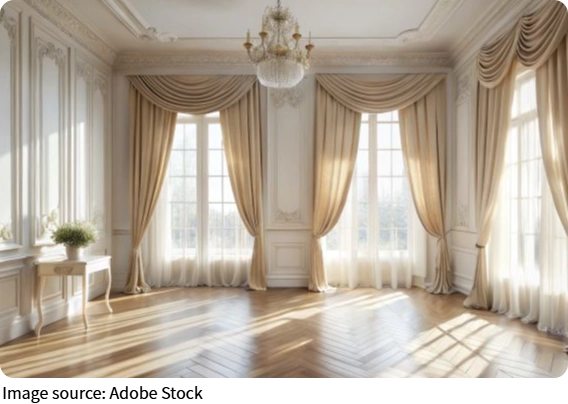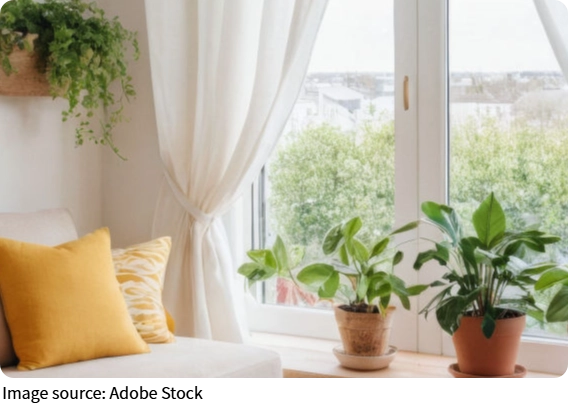Curtain Mood Magic

Ever walked into a room and instantly felt calm, energized, or cozy? That emotional reaction often has a lot to do with the curtains. Curtains are not just practical—they’re powerful mood-setters.
From sheer elegance to dramatic flair, the right window treatments can transform how a space feels without changing the structure at all. Let’s explore how to use curtains to create a well-balanced, mood-enhancing room you’ll love spending time in.
Understand the Emotional Power of Fabric
Curtains are large surfaces in any room and naturally attract the eye. This makes them perfect for setting the tone. Light fabrics like voile or linen bring in softness and airiness. Heavier materials such as velvet or thick cotton offer warmth, comfort, and a touch of sophistication.
Think about how you want the room to feel:
• Calm and peaceful? Go for flowing, soft-textured curtains in muted tones.
• Bold and energetic? Choose heavier fabrics in striking colors or patterns.
The texture of the curtain plays a crucial role. For example, rough linen brings a rustic and relaxed mood, while silk reflects light and adds luxury.
Let Light Work Its Magic
Lighting dramatically changes how a room feels—and curtains control the light. Sheer curtains filter sunlight, creating a gentle glow that's perfect for bedrooms or living rooms. This filtered light softens edges and creates a dream-like ambiance.
For spaces where brightness is key, such as kitchens or home offices, consider lightweight curtains that allow maximum daylight. In contrast, blackout curtains are ideal for media rooms or bedrooms where darkness promotes better sleep and focus.
Layering is another expert trick: use sheers during the day and heavier outer panels for privacy or dimming at night.
Color Sets the Mood Instantly
Color psychology is real—and curtains are one of the biggest surfaces you can use to influence mood through color.
• Blues and greens evoke calmness and serenity, making them ideal for bedrooms or meditation spaces.
• Yellows and oranges add warmth and optimism, great for kitchens or family areas.
• Grays and soft whites promote balance and neutrality, useful in shared spaces.
• Dark hues like navy or forest green bring depth and elegance to formal areas.
If you're afraid to commit to bold wall colors, curtains are a safe but impactful way to experiment with color.
Patterns Add Personality
Plain curtains are timeless, but patterns can introduce energy, charm, or drama into a room. Vertical stripes make ceilings look higher. Floral patterns soften a modern space. Geometric prints create a dynamic, contemporary vibe.
Just remember: in small rooms, subtle patterns are often better, while large spaces can handle bold, oversized prints.
Coordinate the curtain pattern with other soft elements like cushions or rugs to unify the look without overwhelming the room.
Length and Placement Matter
The length and height at which you hang your curtains can change the entire feel of the room. Floor-length curtains make a space feel taller and more elegant. Hanging your curtains higher—just below the ceiling line—gives the illusion of higher ceilings and a more spacious environment.
Letting the curtains "kiss" or lightly touch the floor is perfect for a tailored look. Letting them puddle slightly adds a romantic, soft touch. Avoid curtains that are too short—they visually chop the room and disrupt the mood.
Layering for Comfort and Style
One of the most underrated techniques in curtain styling is layering. Using a combination of sheer and opaque panels lets you adjust both light and privacy throughout the day.
Layering also adds depth and richness to your window area. Use a double curtain rod or tiebacks to create a dynamic and adaptable curtain design. This approach is especially effective in bedrooms, where light control and comfort are key.
Match Curtains to Room Function
Different rooms require different moods, and your curtains should support that purpose.
• Living room: Choose light-filtering curtains to keep the room bright and welcoming.
• Bedroom: Opt for lined or blackout curtains to ensure restful sleep.
• Dining room: Elegant materials like velvet or silk can create a luxurious, intimate atmosphere.
• Home office: Light-colored curtains that allow natural light while reducing glare will enhance focus.
Always match the mood to the function, not just the aesthetic.
Use Tiebacks and Hardware to Elevate Mood
Even the accessories matter. Curtain rods, tiebacks, and hooks can act as jewelry for your windows. Metallic finishes (like brushed gold or matte black) bring different moods—glamorous or industrial—depending on your chosen style.
Tiebacks can give structure during the day and add a sculptural element. For example, rope tiebacks add a coastal or rustic feel, while crystal ones feel formal and glamorous.
Keep Things Harmonious
The mood of a space depends on how all the elements work together. Curtains should harmonize with furniture, rugs, wall colors, and lighting. Too many contrasting patterns or clashing tones can confuse the eye and disrupt the calm.
Interior designer Laura Marks emphasizes, "A well-balanced room has curtains that support the overall emotional message of the space. They shouldn't overpower—they should complete the story."
Try Seasonal Curtain Switching
Changing your curtains seasonally is a wonderful way to refresh the mood of a space without a full makeover.
• Spring/Summer: Light, airy fabrics in pale colors keep the room feeling cool and open.
• Autumn/Winter: Heavier materials in warm tones add comfort and insulation.
This simple rotation keeps the space aligned with the seasons and emotionally in tune with your needs.

Curtains are more than just window coverings—they're emotional design tools. By choosing the right fabric, color, pattern, and placement, you can shape how a room feels every single day.
Have you experimented with curtains to change your room's mood? Tell us how it turned out—or what you'd like to try next! Your story might just inspire someone else's dream space.

 · Lifestyle Team
· Lifestyle Team